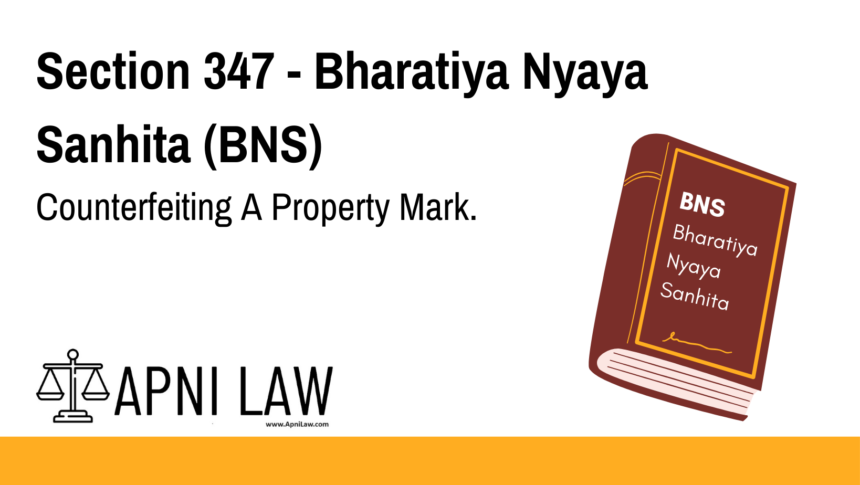Code: Section 347 BNS
Offense Related to Counterfeiting Property Marks
(1) Whoever counterfeits any property mark used by any other person shall be
punished with imprisonment of either description for a term which may extend to two years,
or with fine, or with both.
(2) Whoever counterfeits any property mark used by a public servant, or any mark
used by a public servant to denote that any property has been manufactured by a particular
person or at a particular time or place, or that the property is of a particular quality or has
passed through a particular office, or that it is entitled to any exemption, or uses as genuine
any such mark knowing the same to be counterfeit, shall be punished with imprisonment of
either description for a term which may extend to three years, and shall also be liable to fine.
Explanation of Section 347 BNS
Section 347 of the Bharatiya Nyaya Sanhita (BNS) deals with the serious offense of counterfeiting property marks. A property mark is an identifier used to denote the ownership, origin, quality, or other specific characteristics of movable property. Counterfeiting such marks can lead to fraud, misrepresentation, and financial loss.
This section distinguishes between two types of counterfeiting:
- Counterfeiting a Property Mark Used by Any Person (Subsection 1):
- Applies to general cases where someone reproduces or imitates another person’s property mark without permission.
- Punishment: Up to 2 years of imprisonment, a fine, or both.
- Counterfeiting a Property Mark Used by a Public Servant (Subsection 2):
- Covers marks used by public servants to indicate official details, such as manufacturing origin, quality certification, exemptions, etc.
- Punishment: Up to 3 years of imprisonment, plus a fine.
Illustration
Example 1: Counterfeiting a Brand Logo
A person creates fake handbags and uses the logo of a popular luxury brand without permission. This act constitutes counterfeiting under Section 347(1) because the mark belongs to another person.
Example 2: Forging an Official Quality Mark
A manufacturer falsifies the “ISO Certified” mark on substandard products to mislead customers. Since the mark is associated with a public standard, this would fall under Section 347(2), attracting a harsher penalty.
Common Questions and Answers on Section 347 BNS
1. What is considered counterfeiting under Section 347?
- Answer: Counterfeiting involves making or using a fake property mark that imitates an official or legitimate mark to deceive others.
2. What is the punishment for counterfeiting a private property mark?
- Answer: Imprisonment up to 2 years, a fine, or both.
3. Why is counterfeiting a public servant’s mark punished more severely?
- Answer: Because it undermines public trust in official certifications, potentially endangering public safety, health, or financial integrity.
4. Can someone be punished if they didn’t intend to defraud?
- Answer: Yes, the section focuses on the act of counterfeiting itself, not just the intent. However, the severity of the penalty may vary depending on the circumstances.
Conclusion
Section 347 of the Bharatiya Nyaya Sanhita (BNS) plays a crucial role in preventing fraud and maintaining the integrity of property marks. By criminalizing the act of counterfeiting—especially when it involves public servants’ marks—the law ensures that businesses, consumers, and the public are protected from deceptive practices.










